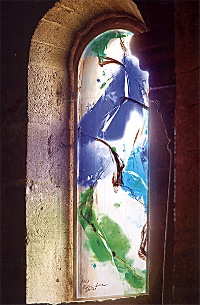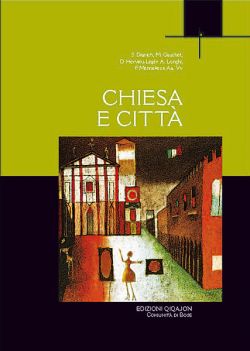Press release
III International Liturgical Conference
LITURGY AND ART
The challenge of today's world
Bose, 3-5 June 2010
Monastery of Bose
National Office for the Cultural Heritage of the Church – CEI
 PRESS RELEASE
PRESS RELEASE
Tuesday, 25 May 2010
From Thursday, 3 June, through Saturday, 5 June 2010, the VIIIth International Liturgical Conference will be held at the Monastery of Bose (Magnano BI). The Conference, under the auspices of the Monastery of Bose in collaboration with the National Office for the Cultural Heritage of the Church of the Italian Bishops’ Conference, will have as its theme Liturgy and Art: the Challenge of Today’s World. The opening session of the Conference will be presided jointly by Enzo BIANCHI, prior of Bose, and mons. Stefano RUSSO, director of the National Office for the Cultural Heritage of the Church — CEI.
Among the personalities present there will be: Gianfranco RAVASI, president of the Pontifical Council for Culture, archbishop Piero MARINI, president of the Pontifical Committee for the International Eucharistic Congresses, mons. Gabriele MANA, bishop of Biella, mons. Arrigo MIGLIO, bishop of Ivrea, secretary of the Bishops’ Conference of Piedmont.
In addition, there will be present: the metropolitan of Kaisariani, Vyron, and Hymettos DANIEL (Pourtsouklis), official delegate of the Holy Synod of the Orthodox Church of Greece; archimandrite Job GETCHA of Paris, official delegate of the ecumenical Patriarchate of Constantinople; the rev. dr. David STANCLIFFE, bishop of Salisbury, official delegate of the Archbishop of Canterbury. This attests to the ecumenical dimension of the Conference, at which will participate Catholic, Orthodox, Lutheran, Anglican, and Reformed scholars.
Besides participants from Italy, numerous others will come from other countries: Austria, Belgium, Brazil, France, Germany, Greece, Hungary, Indonesia, Ireland, Poland, Portugal, Switzerland, United Kingdom, United States, Vatican City. The presence of monks from Italy and abroad testifies to the faithful attention of the monastic world to liturgical topics.
Now in its eighth edition, the International Liturgical Conferences are an annual appointment at which international scholars and experts belonging to various Christian Churches meet to discuss topics on the relation between liturgy, architecture, and art. In this way a place is offered to the public present, composed of theologians, liturgists, architects, artists, persons responsible for building places of worship and those interested in a specific topic where they can come together for a common reflection, animated by the desire to see Christian liturgical space given its due value.
The Scientific committee in charge of the organization of the International Liturgical Conferences of Bose is composed by: Enzo Bianchi (Bose), Stefano Russo (Roma), Goffredo Boselli (Bose), Frédéric Debuyst (Laouvain-la-Neuve), Paul De Clerck (Bruxelles), Albert Gerhards (Bonn), Angelo Lameri (Roma), Keith Pecklers (Roma), Giancarlo Santi (Milano).
Research project of the Conference
The relation of the Church to the arts has for long been an object of debate. In Europe and elsewhere attempts have been made to improve these relations ever since Paul VI deplored their interruption in his renowned discourse of 1964, to which pope Benedict XVI referred in his meeting with artists on 21 November 2009, when he too emphasized how much the Church has need of artists. The VIIIth International Liturgical Conference of Bose intends to deal with the real tension that exists between the claim to autonomy by art and its assumption to the Church’s service.
In the relation between liturgy and art it will be necessary first of all to clarify whether the usual distinction among ars religiosa, ars sacra, and ars liturgica can be of help. The discussion will be conducted in the widest possible vista of an aesthetic of the Christian faith and its expression in the liturgy. Faith, in fact, seeks to be rendered perceptible not only in listening to the word of God, but also through the other senses, especially that of sight. The dimension of sense proper to the Christian faith belongs to the essence of Christianity as revealed religion; the mystery of the incarnation continues to operate in the Church’s sacramental structure and its liturgy. This relation constituted the theological basis that marked the end of iconoclasm and made possible an immense artistic production in the Churches in both East and West.
In the measure in which art represents a “language” that can transmit the experience of what is transcendent, there is an analogy with the liturgy in its symbolic verbal and non-verbal language. Nevertheless, the liturgy is actio sacra, while the figurative arts are static and suspend the experience of the flow of time by shifting it to the observer’s intimate depths. This is their force, in the measure that they prolong beyond the instant the experience of the meeting with God in word and sacrament. Throughout the Church’s history, however, there continue to be iconoclastic tendencies that would like to put an end to the temptation to depict what cannot be depicted.
The discourse on art and the Church has been conducted almost exclusively from the side of the Church, by the magisterium and by theologians. If the Church requires the artist to wok in conformity with the liturgy, is she disposed to have artists require something from her? Artists are supposed to serve only the requirement of beauty of the Church, and other registers of human experience, as happens in contemporary art, are not to be received? The popes have recognized this task of artists. John Paul II has spoken of art as a “voice of expectation of universal redemption, while Benedict XVI has affirmed that “art should disquiet, science reassure”.
The liturgical conference will use a wide concept of “image”. A distinction should be made between primary and secondary images. The primary image is the liturgical assembly itself (Christ and the visible community) in its various communicative actions. Aniconic liturgical spaces, such as Cistercian churches, churches of the Reform, and churches of the twentieth century, are not empty of images, although they do not exhibit any or few images in the classic sense. Not by chance the liturgical movement of the twentieth century preferred to a great extent churches without images, because greater importance was given to the primary image, which is the liturgical action itself. At the beginning of the last century there was often a removal and a reduction of many images that had accumulated in historical churches, but towards the end of the 1900s images returned in a large part of Europe, and someone spoke of an “iconoclasm in reverse”. We have to ask whether there is a risk that images become again, as had happened already in the nineteenth century, a surrogate of the liturgical celebration, which often is defective in language, in expression, and in eloquence.
The conference will gather the experience of architects, of artists of the figurative arts, and of theologians to reflect on how the separation “between temple and museum” (Alex Stock) is to be dealt with. In addition, there will be a presentation of experiences of encounters between liturgy and contemporary art in several European countries and within various Christian confessions.
Themes and speakers at the Conference
In the inaugural lecture the prior of Bose, ENZO BIANCHI, will set out the decisive importance that the arts have always had within Christian liturgy and the great contribution that contemporary art is still called upon to offer in this field today. Mons. STEFANO RUSSO, director of the National Office for the Cultural Heritage of the Church, will indicate the commitment of the Italian Bishops’ Conference to promoting a dialogue with artists. To the German theologian JOHANNES RAUCHENBERGER of the Catholic Theological Faculty of the University of Vienna has been confided the task of clearing up the essential distinction among religious art, sacred art, and liturgical art. The French liturgist FRANÇOIS CASSINGENA-TRÈVEDY of the Catholic Institute of Paris will demonstrate how art in the liturgy has a sacramental significance and value, that is, it is not an ornamental, but a constitutive part of the liturgical action. The Swiss theologian ERIC FUCHS of the Faculty of Protestant Theology of the University of Geneva will develop the theme of liturgical art as the visibility of the Word of God. The well-known art historian FRANÇOIS BOESPFLUG of the University Marc Bloch of Strasbourg will invert the terms of the conference to show how Christian liturgy presents a real and proper challenge to contemporary art. The bishop of Salisbury, DAVID STANCLIFFE, will present the experience in the Anglican Church of the encounter between liturgy and contemporary art. One session of the conference will be reserved to the presentation of several examples of collaboration between artists, those commissioning a work of art, and the community in dialogue. TIZIANO GIRELLI, director of the Diocesan Office for the Cultural Heritage of the Church of the diocese of Reggio Emilia, will illustrate the practice still continuing today in the cathedral of Reggio Emilia. The art of incarnating light in matter, that is, contemporary stained glass in France, will be illustrated by PHILIPPE MARKIEWICZ, director of the review Arts sacrés. WALTER ZAHNER, member of the Commission on sacred art of the German Bishops’ Conference, will speak on the experience in the German world. The American critic JOHN BUSCEMI will present the Rothko Chapel in Houston as an example of collaboration between artists and those who commission a work of art.
Especially interesting are the talks of the final day. The Orthodox theologian and essayist JEAN-FRANÇOIS COLOSIMO, recently nominated president of the Centre Nationale du Livre, will discuss the complex problem of the relation between Orthodoxy and contemporary art. Archbishop GIANFRANCO RAVASI, president of the Pontifical Council for Culture, will give the final talk of the conference with the title Art, provocation and wound. The German theologian ALBERT GERHARDS of the University of Bonn has been asked to give a summary of the conference proceedings.
At the conclusion of the Conference there will take place the official presentation of the Proceedings of last year’s conference: Chiesa e Città, ed. G. Boselli (edizioni Qiqajon: Magnano 2010), added to the series of the Proceedings of past conferences.
